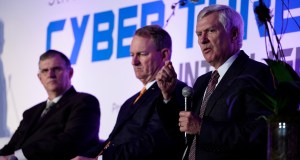The new ‘I’ in CIO

Illustration from 2015 Federal CIO and CISO Survey. (Professional Services Council and Grant Thornton)
Federal chief information officers have no shortage of challenges, but one of the most vexing is how to meet the growing demands to help agencies innovate while also delivering new enterprise IT services more cheaply — and more rapidly.
That was broadly confirmed in a new survey of government CIOs and chief information security officers released Monday by the Professional Services Council and Grant Thornton LLC. The study, the latest in a 25-year run of surveys assessing the state of federal CIOs, provides the usual Rorschach test of federal IT priorities. But it also suggests that the role of the federal CIO is evolving into new — and welcome — territory.
Despite the intent of the Clinger-Cohen Act to give federal CIOs greater executive authority nearly 20 years ago, the job of CIO has continued to mean different things to different agencies. In reality, the “I” in CIO often stood as much for infrastructure or IT operations as it did for information.
This latest survey, however, gives new evidence to the recognition that federal CIOs are increasingly being cast in the role of chief innovation officer, not unlike their commercial sector counterparts, albeit in an environment that remains relatively hostile to innovative practices.
The renewed — if not exactly new — focus on innovation stems from several factors.
One is the continuing mandate to cut costs. The U.S. Census Bureau, for instance, is “committed to taking $5 billion out the cost of the 2020 census,” according to Commerce Department CIO Steve Cooper. That would be a significant achievement, given the 2010 cost around $13 billion. Agencies across the federal government are facing similar mandates. “The only way we can do that is through the innovative use of technology,” Cooper said at a PSC conference Monday, which coincided with the release of the survey.
The Census Bureau, one of a dozen bureaus Cooper supports, is looking seriously into ways to get households to complete census surveys via the Internet. “If we could do that, it would eliminate a significant cost for enumerators. That’s an example of … thinking differently,” he said.
Another factor is the Federal Information Technology Acquisition Reform Act, enacted last December. FITARA routinely gets described as the most significant federal IT reform since the Clinger-Cohen Act, although many CIOs contend the act does more to reaffirm than actually give new authorities to CIOs.
It does, however, give agencies a new mandate to deliver “world-class digital services” and improve the value of federal IT investments. To do that, agencies will need their CIOs to function more as boardroom strategists, not just IT champions.
David DeVries, principal deputy CIO at the Defense Department, is among those who are seeing the evolving role of the CIO. “Our authorities haven’t changed,” he said. “But our value as CIOs and what we bring to the table is now better appreciated and understood by leadership” in a new and more fundamental way, he explained during the conference.
A third factor is the dramatic evolution of new enterprise capabilities coming from the commercial marketplace. These innovations are taking shape on multiple fronts, CIOs say, including the rise of more modern and agile application development, advances in the adoption of cloud technologies and new tools for gathering and analyzing data.
A final and less obvious factor, though, is the fundamental shift in the way technology is filtering up, instead of down, through organizations.
Intel CIO Kim Stevenson put it succinctly in an interview this week with the Wall Street Journal when she said: “IT isn’t transforming the workforce, what’s happening is the workforce is transforming IT.”
We’ve already seen the steady invasion of smartphones, personal computing devices and a new generation of applications invading the workplace. The ease of procuring cloud computing and other IT services promises to give the workforce — especially younger workers who grew up in a mobile, Web-based world — even greater impetus to bring IT innovations to work.
The successful CIOs in government going forward will be those who understand and harness those IT innovations, even as they are forced to work within the rigid lanes imposed upon them by politics and regulations. All told, however, the ability to make innovation, not just information and infrastructure, part of a CIO’s portfolio is an exciting prospect.
Whether every federal CIO is up to the task of serving as their agency’s chief innovation officer, however, is a fair question.
Cleary, “the CIO’s role is evolving,” said Dave Wennergren, senior vice president of technology policy at PSC, and a former CIO in the Navy and deputy CIO at the Department of Defense. “The landscape is changing. Expectations of CIOs have grown. Recognize you’re a key player. So you have a seat at the table, but is your opinion valued?”
He cited the comment of one CIO interviewed for the survey who suggested, “The CIO role as it is defined today is not likely to exist [in the future].”
“I’m not sure what they would be replaced with,” he told FedScoop. “There’s a clearly a need for a chief strategy officer” who understands how technology supports “mission results.”
In the meantime, federal CIOs still “need some clarity” from government and agency leaders on what they are expected to do, if they are to support innovation, Wennergren said. And they need to know top agency executives are “going to give them the tools [they need] and have their back.”
There’s no question, government agencies need innovation-minded CIOs more than ever. How they attract, retain, and support them is arguably one of the most important questions agency leaders should be asking themselves.






